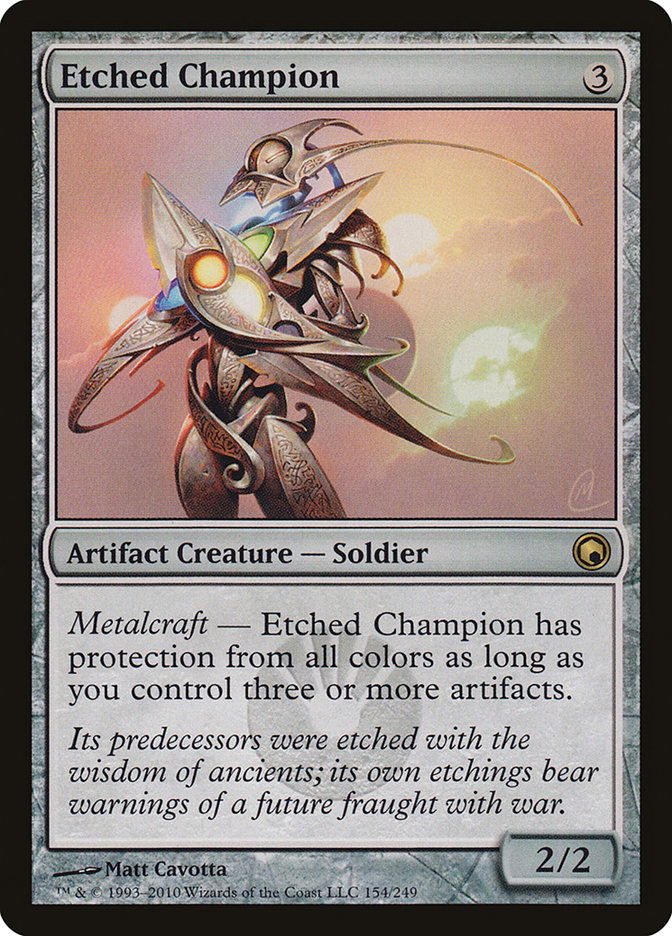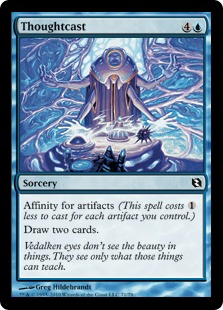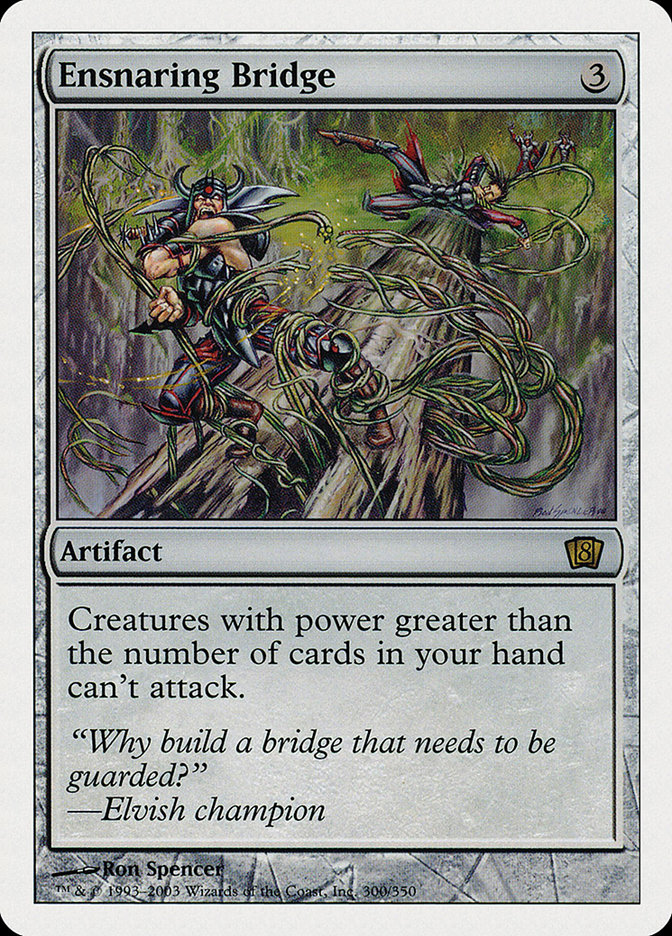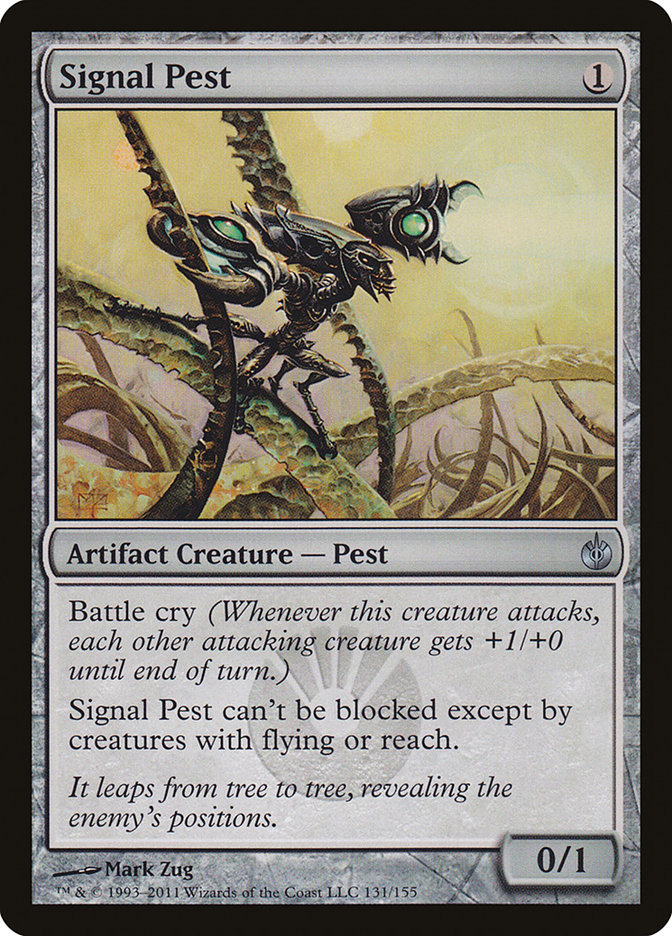I had a lot of fun last weekend playing my new Affinity list at Grand Prix Detroit. It was great to have the Magic Grand Prix circuit once again return to my home state of Michigan and to not have to travel across the country to attend for a change.
I had been looking forward to the Detroit tournament for well over a month and spent it tuning and testing out my Affinity deck in preparation.
Unfortunately, I didn’t do as well as I would have liked in the event. I finished with a pretty mediocre 5-3 record before dropping to go out to eat. Despite not making day 2, I still really like the deck that I chose to play and wouldn’t think twice about taking it to another Modern tournament.
Here is the decklist that I settled upon:
Creatures (26)
- 4 Arcbound Ravager
- 4 Ornithopter
- 4 Steel Overseer
- 2 Memnite
- 4 Etched Champion
- 4 Signal Pest
- 4 Vault Skirge
Lands (16)
Spells (18)
Sideboard

Going into the event I felt really confident in my deck choice and the way that I had built my deck. The two big innovations that I had come up with were to play my disruption in the maindeck and to support this choice by swapping some of my Glimmervoids for City of Brass.
One thing I really like about City of Brass is that it allows me to fire off a turn 1 Thoughtseize without having to also have an artifact in play. Against B/G decks, a lot of the time the card you most want to take is their Thoughtseize or Inquisition of Kozilek to protect a Cranial Plating or Etched Champion you won’t be able to cast until the next turn or so. With Glimmervoid, you often can’t make this play, and I’ve found the loss of life via City of Brass tends to outweigh the drawbacks of Glimmervoid.
It is also worth noting that artifact sweepers that people play post-board, such as Creeping Corrosion, Shatterstorm, and Hurkyl’s Recall, will also wreck your Glimmervoids, which matters.
Get hateful.
One of the more surprising revelations to come out of GP Detroit was the rise of the fair decks. In the tournaments I had played leading up to the event it seemed like various combo and blue decks had become the more popular decks in the format for the moment.
I really fell in love with Thoughtseize in this deck for a variety of reasons. First, when it wasn’t in my maindeck, I sideboarded it in against around 80% of my opponents. If it makes my deck better to have the card, starting it maindeck not only potentially makes me better in a variety of matchups but also opens up sideboard space.
The other reason I like starting Thoughtseize is that Affinity offers many opportunities to make all-in gambits that are extremely high risk and high reward. If you get to Thoughtseize and know your opponent’s hand and have perfect information, it allows you to take better advantage of these opportune moments.
Unstoppable killing machine.
I also moved the fourth Etched Champion from the sideboard to the maindeck. The card is so powerful and so critical against any midrange deck that plans to try to win the game via removing your creatures because it simply doesn’t die to most spot removal.
The best-performing decks at GP Detroit were various Jund and B/G Midrange strategies, and to be honest, I have always really liked Affinity’s matchup against any B/G-style deck. The addition of the fourth Etched Champion to the maindeck and the disruption tend to be very good against midrange decks.
One thing I concluded was that I didn’t really like Thoughtcast in the Affinity deck very much and would rather have some amount of disruption to protect against fast combo and removal spells. It is very possible that Thoughtcast is simply too good to cut from the maindeck and that perhaps my cutting the card was an oversight.
To Thoughtcast or not to Thoughtcast?
If we take a look at Alex Majlaton Affinity list from GP Detroit, the one big difference is the inclusion of Thoughtcast.
Creatures (25)
- 4 Arcbound Ravager
- 4 Ornithopter
- 3 Steel Overseer
- 2 Memnite
- 4 Etched Champion
- 4 Signal Pest
- 4 Vault Skirge
Lands (16)
Spells (19)

A big part of me choosing to omit the card-drawer was my extensive testing against faster combo decks, which led me to believe that disruption was necessary to shore up those matchups.
I’m still not sure about this issue, but reconsidering starting Thoughtcast is a subject I have been giving a lot of consideration. Alex is a fantastic Affinity player, and I am probably apt to follow his lead on playing Thoughtcast in some number at future events.
My actual tournament was a tough one. My matchups were:
U/W/R Twin: Loss, 1-2
Burn: Win, 2-0
Burn: Loss, 1-2
Tron: Loss, 0-2
Junk Prison: Win, 2-0
You know how sometimes it just isn’t your day? Well, Saturday just wasn’t my day.
I was surprised to lose to Tron because I think that Affinity tends to be pretty good against it, but in general Burn and U/W/R Twin were not the kind of decks I was hoping to play against at this event.
I felt pretty smart about starting City of Brass and Thoughtseize, but facing Burn in back-to-back rounds was brutal, as it is pretty much the one deck that punishes those decisions in a big way.
Of the six games that I lost, four of those games I had the win on board for the next turn unless my opponent topdecked something very specific, only to have that topdeck happen. In a few cases, my opponent had to runner-runner me in order to not lose.
I won’t bore you with the specifics because ultimately they don’t matter too much. The point of me bringing it up at all is that I felt the deck in nearly every game that I lost put me into a position to where I was highly favored to win the game, which is basically all anybody can really ask for from a deck.
I will, however, bore you with the details of a cool game that I had in my last round against the Junk Prison deck.
My opponent had Ensnaring Bridge and a Liliana ticked way up, and we were playing the game of I draw a card and don’t play it to stay out of range of his Shrieking Afflictions.
Bridge and hellbent? No problem, I’ve got Ornithopters for days . . .
I finally drew a second City of Brass, played a Cranial Plating, attacked with my Ornithopter, equipped at instant speed to kill his Liliana of the Veil, and then moved the Plating to another creature end of turn.
In the bag, right?
Nope. He drew Stony Silence, played it, and passed.
But just in the nick of time, I drew a Signal Pest and attacked him to death one point at a time!
Nice Ensnaring Bridge, friend!
I was never so happy all of my creatures had no natural offensive stats in my life!
From the perspective of a man who has been attacked by Noble Hierarch in Legacy with an Ensnaring Bridge in play, I have a special appreciation for that game.
So after a day full of close losses, I decided to end it on the high note of beating a guy who was hellbent with Ensnaring Bridge, Liliana of the Veil, Shrieking Affliction, and Stony Silence.
I’d never beat Stony Silence before, so it was nice to get over that hump for the first time (even if it was in a moot effort overall since I was out of day 2 contention.).
It’s important to look on the bright side of things.
Despite not placing nearly as well as I had hoped, I had an absolute blast at Grand Prix Detroit and wouldn’t hesitate to sleeve up Affinity in the future. In fact, I haven’t unsleeved Affinity since GP Kansas City and have no plans to do so any time soon.
Check me out here next week for my Theros Vintage set review!
Cheers,
Follow me on Twitter @Briandemars1







